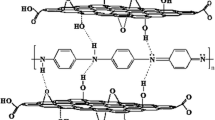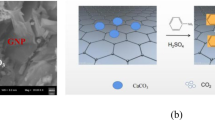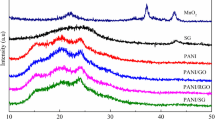Abstract
A high-performance reduced graphene oxide–polyaniline (RGO-PANI) electrode material was prepared through commercially viable, facile one-pot synthesis, applying famed diazotization chemistry and grafting strategy. In this work, 4-nitroaniline was utilized as a grafting substrate to bind reduced graphene oxide and polyaniline covalently to a highly stable and efficient supercapacitor electrode material. The chemical composition and structural analysis of covalently functionalized RGO-PANI nanocomposites were characterized by X-ray diffraction, field-emission scanning electron microscopy, Raman spectroscopy, UV–visible spectroscopy, and Fourier-transform infrared spectroscopy. The electrochemical behavior of the nanocomposites was analyzed through cyclic voltammetry, galvanostatic charge and discharge, and electrochemical impedance spectroscopy. The prepared nanocomposite shows a high specific capacitance of 490 F g−1 in 1 M Na2SO4 with outstanding cyclic stability (10,000 cycles). The applied covalent functionalization through grafting strategy was the principal factor for both high specific capacitance and excellent cyclic stability.
Graphical abstract










Similar content being viewed by others
References
Aricò AS, Bruce P, Scrosati B, Tarascon J-M, Van Schalkwijk W (2005) Nanostructured materials for advanced energy conversion and storage devices. Nat Mater 4:366–377
Arjun N, Pan G-T, Yang TC (2017) The exploration of Lanthanum based perovskites and their complementary electrolytes for the supercapacitor applications. Results Phys 7:920–926
Baker CO, Huang X, Nelson W, Kaner RB (2017) Polyaniline nanofibers: broadening applications for conducting polymers. Chem Soc Rev 46:1510–1525
Basnayaka PA, Ram MK (2017) A review of supercapacitor energy storage using nanohybrid conducting polymers and carbon electrode materials. In: Kalia S (ed) Conducting polymer hybrids. Springer, Berlin, pp 165–192
Behera SR, Dash DP (2017) The effect of urbanization, energy consumption, and foreign direct investment on the carbon dioxide emission in the SSEA (South and Southeast Asian) region. Renew Sustain Energy Rev 70:96–106
Bertinelli F, Palmieri P, Brillante A, Taliani C (1977) Electronic-excited states of nitroanilines. II. A configuration interaction study and UV spectrum of the paranitroaniline single crystal. Chem Phys 25:333–341
Borenstein A, Hanna O, Attias R, Luski S, Brousse T, Aurbach D (2017) Carbon-based composite materials for supercapacitor electrodes: a review. J Mater Chem A 5(25):12653–12672
Chen J, Yao B, Li C, Shi G (2013) An improved Hummers method for eco-friendly synthesis of graphene oxide. Carbon 64:225–229
Chen J et al (2016) The origin of improved electrical double-layer capacitance by inclusion of topological defects and dopants in graphene for supercapacitors. Angew Chem Int Ed 55:13822–13827
Chen F, Wan P, Xu H, Sun X (2017a) Flexible transparent supercapacitors based on hierarchical nanocomposite films. ACS Appl Mater Interfaces 9(21):17865–17871
Chen L-F, Lu Y, Yu L, Lou XWD (2017b) Designed formation of hollow particle-based nitrogen-doped carbon nanofibers for high-performance supercapacitors. Energy Environ Sci 10(8):1777–1783
Dai W et al (2016) Fabrication of sandwich nanostructure graphene/polyaniline hollow spheres composite and its applications as electrode materials for supercapacitor. Mater Res Bull 76:344–352
Dong L, Xu C, Li Y, Huang Z-H, Kang F, Yang Q-H, Zhao X (2016) Flexible electrodes and supercapacitors for wearable energy storage: a review by category. J Mater Chem A 4:4659–4685
Dreyer DR, Park S, Bielawski CW, Ruoff RS (2010) The chemistry of graphene oxide. Chem Soc Rev 39:228–240
Eng AYS, Chua CK, Pumera M (2016) Facile labeling of graphene oxide for superior capacitive energy storage and fluorescence applications. Phys Chem Chem Phys 18:9673–9681
Feng H, Cheng R, Zhao X, Duan X, Li J (2013) A low-temperature method to produce highly reduced graphene oxide. Nat Commun 4:1539. https://doi.org/10.1038/ncomms2555
Gao Z et al (2014) Chemically grafted graphene-polyaniline composite for application in supercapacitor. Electrochim Acta 133:325–334. https://doi.org/10.1016/j.electacta.2014.04.033
González A, Goikolea E, Barrena JA, Mysyk R (2016) Review on supercapacitors: technologies and materials. Renew Sustain Energy Rev 58:1189–1206
Guo B et al (2017) Redox-active organic molecules functionalized nitrogen-doped porous carbon derived from metal-organic framework as electrode materials for supercapacitor. Electrochim Acta 223:74–84
Hong X, Zhang B, Murphy E, Zou J, Kim F (2017) Three-dimensional reduced graphene oxide/polyaniline nanocomposite film prepared by diffusion-driven layer-by-layer assembly for high-performance supercapacitors. J Power Sources 343:60–66
Hwang M, Oh J, Kang J, Seong K-D, Piao Y (2016) Enhanced active sites possessing three-dimensional ternary nanocomposites of reduced graphene oxide/polyaniline/Vulcan carbon for high-performance supercapacitors. Electrochim Acta 221:23–30
Konios D, Stylianakis MM, Stratakis E, Kymakis E (2014) Dispersion behavior of graphene oxide and reduced graphene oxide. J Colloid Interface Sci 430:108–112
Krukiewicz K, Katunin A (2016) The effect of reaction medium on the conductivity and morphology of polyaniline doped with camphor sulfonic acid. Synth Met 214:45–49
Kudin KN, Ozbas B, Schniepp HC, Prudomme RK, Aksay IA, Car R (2008) Raman spectra of graphite oxide and functionalized graphene sheets. Nano Lett 8:36–41
Kumar NA (2012) Polyaniline-grafted reduced graphene oxide for efficient electrochemical supercapacitors. ACS Nano 6:1715–1723. https://doi.org/10.1021/nn204688c
Kumar M et al (2013) Synthesis and characterization of covalently-grafted graphene–polyaniline nanocomposites and its use in a supercapacitor. Chem Eng J 231:397–405. https://doi.org/10.1016/j.cej.2013.07.043
Li W, Yao H, Zhang G, Yang Y (2017) A Ni/Zn bi-metallic coordination supramolecular network applied for high-performance energy storage material. Electrochim Acta 228:233–240
Ma H, He J, Xiong D-B, Wu J, Li Q, Dravid V, Zhao Y (2016) Nickel cobalt hydroxide@ reduced graphene oxide hybrid nanolayers for high-performance asymmetric supercapacitors with remarkable cycling stability. ACS Appl Mater Interfaces 8:1992–2000
Marcano DC et al (2010) Improved synthesis of graphene oxide. ACS Nano 4(8):4806–4814
Matthews M, Pimenta M, Dresselhaus G, Dresselhaus M, Endo M (1999) Origin of dispersive effects of the Raman D band in carbon materials. Phys Rev B 59:R6585
Mokhtar N, Chye DAT, Phang SW (2017) Morphology, conductivity and microwave absorption behavior of polyaniline nanocomposites after chemical treatment. Polym Polym Compos 25:545
Mondal S, Rana U, Malik S (2017) Reduced graphene oxide/Fe3O4/polyaniline nanostructures as electrode materials for an all-solid-state hybrid supercapacitor. J Phys Chem C 121:7573–7583
Mousavi MF, Hashemi M, Rahmanifar MS, Noori A (2017) Synergistic effect between redox additive electrolyte and PANI-rGO nanocomposite electrode for high energy and high power supercapacitor. Electrochim Acta 228:290–298
Palanisamy S, Chen S-M, Sarawathi R (2012) A novel nonenzymatic hydrogen peroxide sensor based on reduced graphene oxide/ZnO composite modified electrode. Sens Actuators B Chem 166:372–377
Palanisamy S, Ku S, Chen S-M (2013) Dopamine sensor based on a glassy carbon electrode modified with a reduced graphene oxide and palladium nanoparticles composite. Microchim Acta 180:1037–1042
Palanisamy S et al (2017a) A novel laccase biosensor based on laccase immobilized graphene-cellulose microfiber composite modified screen-printed carbon electrode for sensitive determination of catechol. Sci Rep 7:41214
Palanisamy S et al (2017b) Synthesis and characterization of polypyrrole decorated graphene/β-cyclodextrin composite for low level electrochemical detection of mercury (II) in water. Sens Actuators B Chem 243:888–894
Salunkhe RR et al (2014) Fabrication of symmetric supercapacitors based on MOF-derived nanoporous carbons. J Mater Chem A 2:19848–19854
Salunkhe RR, Young C, Tang J, Takei T, Ide Y, Kobayashi N, Yamauchi Y (2016) A high-performance supercapacitor cell based on ZIF-8-derived nanoporous carbon using an organic electrolyte. Chem Commun 52:4764–4767
Sumboja A, Foo CY, Wang X, Lee PS (2013) Large areal mass, flexible and free-standing reduced graphene oxide/manganese dioxide paper for asymmetric supercapacitor device. Adv Mater 25:2809–2815
Sun G et al (2014) Fabrication of ultralong hybrid microfibers from nanosheets of reduced graphene oxide and transition-metal dichalcogenides and their application as supercapacitors. Angew Chem 126:12784–12788
Sun H, She P, Xu K, Shang Y, Yin S, Liu Z (2015) A self-standing nanocomposite foam of polyaniline@ reduced graphene oxide for flexible super-capacitors. Synth Met 209:68–73
Takahashi A et al (2017) Effect of evacuation on liver function after the Fukushima Daiichi Nuclear Power Plant accident: the Fukushima Health Management Survey. J Epidemiol 27:180–185
Tayel MB, Soliman MM, Ebrahim S, Harb ME (2016) Sprayed polyaniline layer onto chemically reduced graphene oxide as electrode for high performance supercapacitor. Synth Met 217:237–243
Unnikrishnan B, Wu C-W, Chen I-WP, Chang H-T, Lin C-H, Huang C-C (2016) Carbon dot-mediated synthesis of manganese oxide decorated graphene nanosheets for supercapacitor application. ACS Sustain Chem Eng 4:3008–3016
Velusamy V, Palanisamy S, Chen S-M, Chen T-W, Selvam S, Ramaraj SK, Lou B-S (2017) Graphene dispersed cellulose microfibers composite for efficient immobilization of hemoglobin and selective biosensor for detection of hydrogen peroxide. Sens Actuators B Chem 252:175–182
Wang G, Zhang L, Zhang J (2012a) A review of electrode materials for electrochemical supercapacitors. Chem Soc Rev 41:797–828
Wang H, Maiyalagan T, Wang X (2012b) Review on recent progress in nitrogen-doped graphene: synthesis, characterization, and its potential applications. ACS Catal 2:781–794
Wu W, Li Y, Yang L, Ma Y, Pan D, Li Y (2014) A facile one-pot preparation of dialdehyde starch reduced graphene oxide/polyaniline composite for supercapacitors. Electrochim Acta 139:117–126
Xia X et al (2014) Synthesis of free-standing metal sulfide nanoarrays via anion exchange reaction and their electrochemical energy storage application. Small 10:766–773
Xia C, Jiang Q, Zhao C, Beaujuge PM, Alshareef HN (2016) Asymmetric supercapacitors with metal-like ternary selenides and porous graphene electrodes. Nano Energy 24:78–86
Xiong C et al (2017) Two-step approach of fabrication of interconnected nanoporous 3D reduced graphene oxide-carbon nanotube-polyaniline hybrid as a binder-free supercapacitor electrode. J Alloys Compd 695:1248–1259
Yadav B, Ali I, Kumar P, Yadav P (2007) FTIR and laser Raman spectra of 2-hydroxy-5-methyl-3-nitropyridine. Indian J Pure Appl Phys 45:979–983
Yamamura H, Yaguchi S, Itoh K (2017) The new radiation emergency medical system in Japan: lessons from the Fukushima Nuclear Plant Accident. Prehospital Disaster Med 32:S4–S4
Yu P, Zhao X, Huang Z, Li Y, Zhang Q (2014) Free-standing three-dimensional graphene and polyaniline nanowire arrays hybrid foams for high-performance flexible and lightweight supercapacitors. J Mater Chem A 2:14413–14420
Yu N, Yin H, Zhang W, Liu Y, Tang Z, Zhu MQ (2016) High-performance fiber-shaped all-solid-state asymmetric supercapacitors based on ultrathin MnO2 nanosheet/carbon fiber cathodes for wearable electronics. Adv Energy Mater 6:1501458
Yuan C, Wu HB, Xie Y, Lou XWD (2014) Mixed transition-metal oxides: design, synthesis, and energy-related applications. Angew Chem Int Ed 53:1488–1504
Zhang J, Jiang J, Li H, Zhao XS (2011) A high-performance asymmetric supercapacitor fabricated with graphene-based electrodes. Energy Environ Sci 4:4009. https://doi.org/10.1039/c1ee01354h
Zhong C, Deng Y, Hu W, Qiao J, Zhang L, Zhang J (2015) A review of electrolyte materials and compositions for electrochemical supercapacitors. Chem Soc Rev 44:7484–7539
Acknowledgements
The authors thank the Centre for Precision Analysis and Research, National Taipei University of Technology, Taipei, for financial support for this research. Also, the authors want to thank Professor Chaochin Su, Department of molecular science and engineering, National Taipei University of Technology, Taipei, for assistance in the electrochemical stability tests.
Author information
Authors and Affiliations
Corresponding author
Rights and permissions
About this article
Cite this article
Arjun, N., Uma, K., Pan, GT. et al. One-pot synthesis of covalently functionalized reduced graphene oxide–polyaniline nanocomposite for supercapacitor applications. Clean Techn Environ Policy 20, 2025–2035 (2018). https://doi.org/10.1007/s10098-018-1573-8
Received:
Accepted:
Published:
Issue Date:
DOI: https://doi.org/10.1007/s10098-018-1573-8




